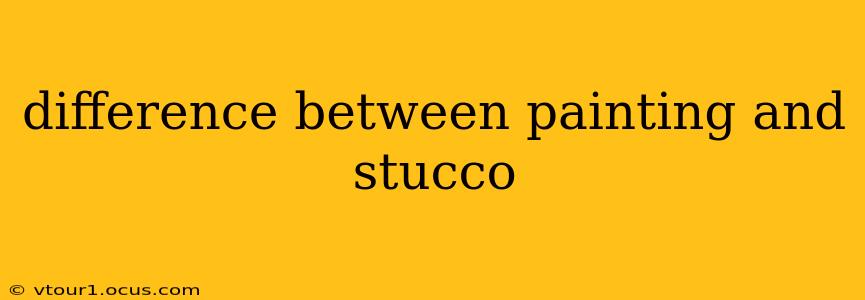Choosing between paint and stucco for your home's exterior or interior walls depends heavily on your aesthetic preferences, budget, and the level of maintenance you're willing to commit to. Both offer distinct advantages and disadvantages. This comprehensive guide will explore the key differences between painting and stucco, helping you make an informed decision.
What is Paint?
Paint is a liquid coating applied to surfaces to protect them from the elements and enhance their appearance. It comes in a vast array of colors, finishes (matte, satin, gloss, etc.), and formulations (oil-based, water-based, etc.). Painting is generally a relatively quick and cost-effective process, making it a popular choice for many homeowners.
What is Stucco?
Stucco is a plaster-like material applied to exterior walls as a protective and decorative layer. It's a mixture of cement, sand, lime, and water. Stucco provides a durable, weather-resistant finish that can last for many years with proper maintenance. It's known for its textured appearance, which adds a unique aesthetic to buildings.
Key Differences Between Painting and Stucco
Here's a breakdown of the major differences between painting and stucco:
1. Material and Application:
- Paint: A liquid applied with brushes, rollers, or sprayers. Requires surface preparation like cleaning and priming.
- Stucco: A cementitious material applied in layers, requiring specialized tools and skilled labor for a smooth, even finish.
2. Cost:
- Paint: Generally less expensive than stucco, both in materials and labor.
- Stucco: Significantly more expensive due to the materials, labor, and specialized skills required for proper application.
3. Durability and Longevity:
- Paint: Less durable than stucco; requires repainting every few years, depending on the quality of the paint and exposure to the elements.
- Stucco: Highly durable and long-lasting, offering superior protection against weather damage, pests, and fire. With proper maintenance, it can last for decades.
4. Maintenance:
- Paint: Requires regular cleaning and repainting to maintain its appearance and protective qualities.
- Stucco: Requires less frequent maintenance than paint. Occasional cleaning and repairs of cracks or chips are typically sufficient.
5. Aesthetics:
- Paint: Offers a wide range of colors and finishes, allowing for customization and versatility.
- Stucco: Provides a textured, often rustic or traditional look. While color choices are available, they are typically limited compared to paint.
6. Repair and Replacement:
- Paint: Relatively easy and inexpensive to repair or repaint.
- Stucco: Repairing damaged stucco can be more complex and costly, requiring the skills of a professional. Large-scale replacement is a significant undertaking.
7. Environmental Impact:
- Paint: Some paints contain volatile organic compounds (VOCs) that can be harmful to the environment. Low-VOC or zero-VOC paints are available.
- Stucco: Generally considered more environmentally friendly than some paint formulations, as it's made from natural materials.
Frequently Asked Questions (FAQ)
Can you paint over stucco?
Yes, you can paint over stucco. However, proper surface preparation is crucial. The stucco should be clean, dry, and free of any loose or damaged areas. A primer may be needed to ensure proper adhesion and to prevent the paint from absorbing into the porous stucco.
Is stucco more expensive than paint?
Yes, stucco is significantly more expensive than paint, both in terms of materials and labor costs. Stucco application requires skilled labor, adding to the overall expense.
Which is better for weather protection, paint or stucco?
Stucco offers superior weather protection compared to paint. It provides a more durable barrier against rain, wind, and extreme temperatures.
How long does stucco last?
With proper maintenance, stucco can last for several decades. Its longevity depends on factors like climate, quality of the application, and maintenance practices.
What are the benefits of using stucco?
Stucco is known for its durability, weather resistance, fire resistance, and unique aesthetic qualities. It adds value to a home and offers long-term protection.
This comprehensive comparison of paint and stucco should provide you with a clear understanding of their differences and help you make the best choice for your specific needs and preferences. Remember to consult with professionals for advice on material selection and application.
